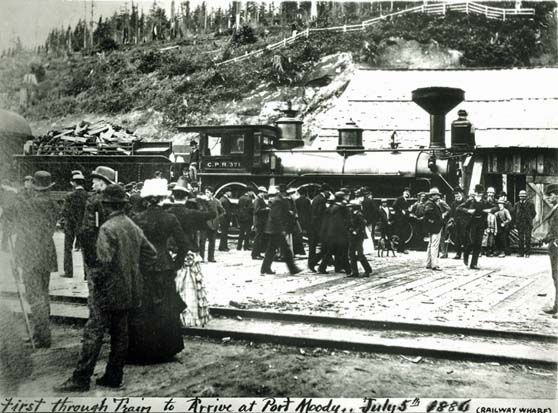
2011
|

13 August 2011
Celebrating 125 Years Since the First Passenger Train
Port Moody British Columbia - When the Last Spike was hammered on 7 Nov 1885 there was a great deal of fanfare at the completion of
this great nation-building achievement. At last, Canada was connected by rail from coast-to-coast, completing a promise to the province of British Columbia and
keeping it within the fledgling country.
And then traffic on the line stopped. One freight train was sent through as a test but the route was not ready for regular traffic. The section through the
Selkirks was barely completed and there was no protection in place from avalanches that slid along the route. The route was abandoned to the elements for the
winter and work began on a series of snowsheds to protect the trains.
The following spring work began on re-opening the line. Crews worked to repair the track through the Selkirks and clear the way for renewed travel. By
late-May, trains could proceed through the mountains.
That paved the way for the departure of the first passenger train. In early June, 1886, it was decided the train would leave Montreal for Port Moody, B.C., on
28 Jun 1886, with daily departures afterwards. A connecting train would start in Toronto and join up along the line.
Tickets for the first train were much sought after, especially for the lone sleeper car, Honolulu. The first ticket was sold to businessman C.I. DeSola of
Montreal. VIP's were conspicuous by their absence, no CP officials were on the first train and Prime Minister Sir John A. McDonald did not make the trip until
a few weeks later.
Many people, including numerous dignitaries came out in the evening of 28 Jul 1886, to see the Pacific Express leave on it's 4,600 kilometre journey from
Montreal to the west coast. The public was allowed on the train prior to its departure. The elegant dining car Holyrood was the star attraction.
The connecting train from Toronto actually left three hours earlier but was a far less heralded departure.
There was a great deal of celebration as the train made its journey west. Bands, fireworks, and bonfires were held in the various towns along the route as the
train passed through.
In Ottawa, the train was delayed for two hours when one of the baggage cars de-coupled from the train.
The train travelled west of Ottawa, along the shores of Lake Nippising. In Sudbury the station was decorated with evergreens and patriotic slogans. It skirted
the shore of massive Lake Superior.
"The scenery along Jack Fish Bay and some distance west is very beautiful indeed," wrote passenger W.F. Salsbury in a letter to his wife.
The train passed through Thunder Bay at night and arrived in Winnipeg on Dominion Day, 1 Jul 1886 at 9 a.m. There, the arrival of the train was made part of
the day's festivities and an artillery salvo greeted the Pacific Express when it arrived in town.
The train continued through the prairies, on through Calgary before it reached the mountains. As the train passed through Kicking Horse canyon, Salsbury
described the views as "too magnificent for description."
The train dropped off a sleeper car at Donald Station and began the winding journey through Rogers Pass to Revelstoke.
"The mountains were all around us," wrote Salsbury. "While we rose higher and higher, the line of railway being cut out of the mountain sides,
below us was the valley and river, which looked as if it were a mile away."
Unfortunately, Salsbury did not write about passing through Revelstoke. Cathy English at the Revelstoke Museum & Archives said there was not much known
about the train's passage through town as there was no local newspaper at the time.
The train arrived at its end point in Port Moody on 4 Jul 1886 at around 2 p.m, where it was greeted by numerous dignitaries from Victoria and nearby towns.
For the residents of Port Moody, the arrival of the first passenger train marked one last hurrah for the small town. Canadian Pacific had already decided to
move its western terminus to Vancouver and many people that had flocked to Port Moody were now making their way a few miles west to settle around the new
terminus.
After that first trip, the Pacific Express turned around and headed back east. Trains left daily except Sunday, allowing people to finally travel across the
country.
Note: Most of the information in this article comes from the book Van Horne's Road, by CP historian Omer Lavallee.
Alex Cooper.

|
